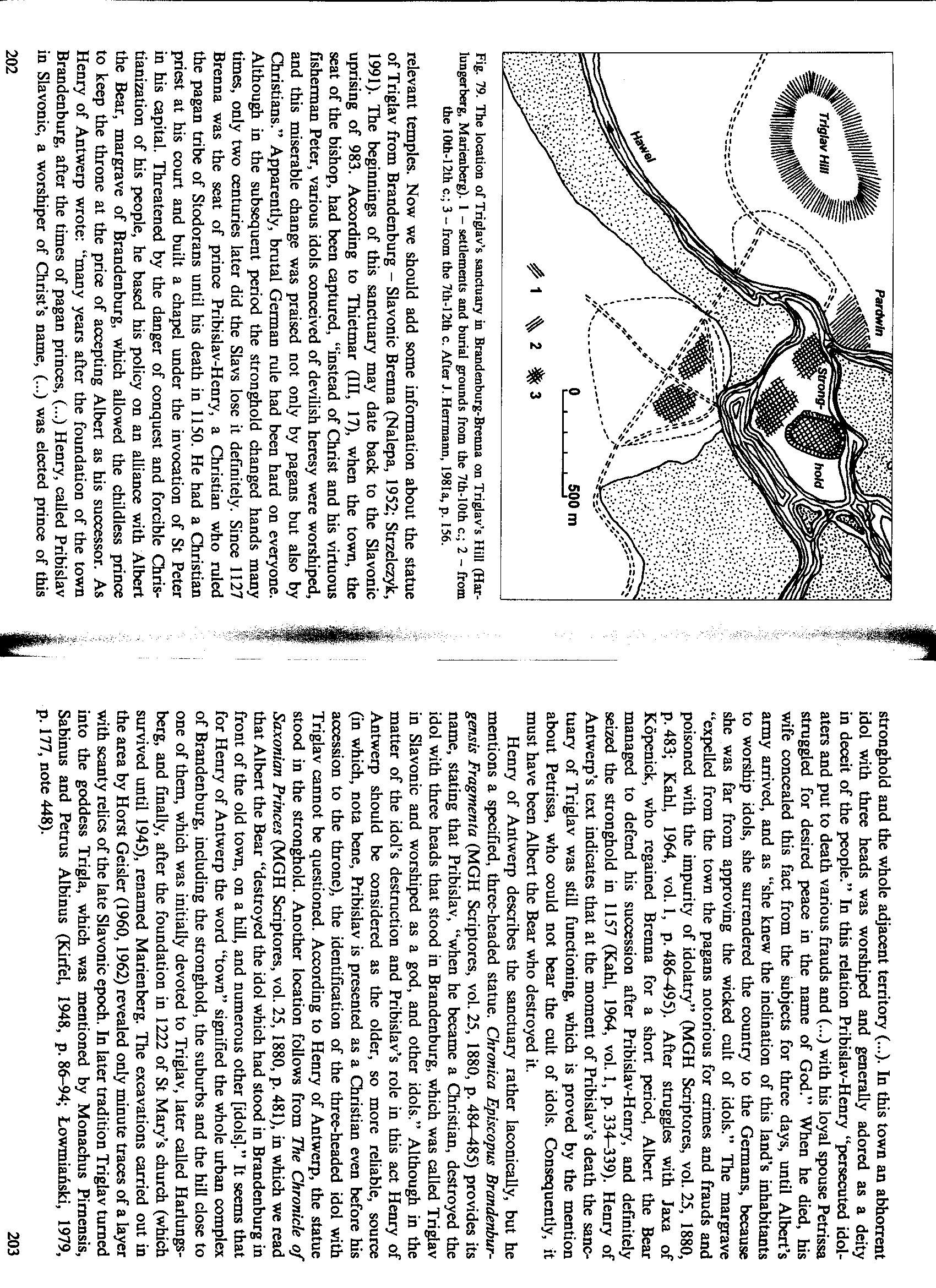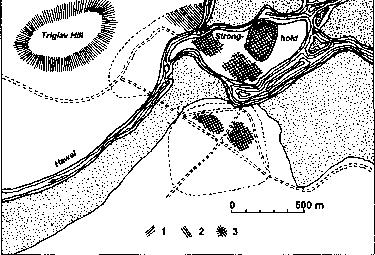image100

Psrdwln

Fig. 79. The location of Triglav’s sanctuary in Brandenburg-Brenna on Triglav’s Hill (Har-lungerberg, Marienberg). 1 - settlements and burial grounds from the 7th-10th c.; 2 - from the 10th-12th c.; 3 - from the 7th-12th c. After J. Hemnann, 1981a, p. 156.
relevant temples. Now we should add some information about the statuę of Triglav from Brandenburg - Slavonic Brenna (Nalepa, 1952; Strzelczyk, 1991). The beginnings of this sanctuary may datę back to the Slavonic uprising of 983. According to Thietmar (III, 17), when the town, the seat of the bishop, had been captured, “instead of Christ and his virtuous fisherman Peter, various idols conceived of devllish heresy were worshiped, and this miserable change was praised not only by pagans but also by Christians.” Apparently, brutal German rule had been hard on everyone. Although in the subseąuent period the stronghold changed hands many times, only two centuries later did the Slavs lose it definitely. Since 1127 Brenna was the seat of prince Pribislav-Henry, a Christian who ruled the pagan tribe of Stodorans until his death in 1150. He had a Christian priest at his court and built a chapel under the invocation of St Peter in his capital. Threatened by the danger of conquest and forcible Chris-tianization of his people, he based his policy on an alliance with Albert the Bear, margrave of Brandenburg, which allowed the childless prince to keep the throne at the price of accepting Albert as his successor. As Henry of Antwerp wrote: “many years after the foundation of the town Brandenburg, after the times of pagan princes, (...) Henry, called Pribislav in Slavonic, a worshiper of Christ’s name, (...) was elected prince of this
stronghold and the whole adjacent territory (...)• In this town an abhorrent idol with three heads was worshiped and generally adored as a deity in deceit of the peopłe.” In this relation Pribislav-Henry “persecuted idol-aters and put to death various frauds and (...) with his loyal spouse Petrissa struggled for desired peace in the name of God.” When he died, his wife concealed this fact from the śubjects for three days, until Albert’s army arrived, and as “she knew the inciination of this land’s inhabitants to worship idols, she surrendered the country to the Germans, because she was far from approving the wicked cult of idols.” The margrave “expelled from the town the pagans notorious for crimes and frauds and poisoned with the impurity of idolatry” (MGH Scriptores, vol. 25, 1880, p. 483; Kahl, 1964, vol. 1, p. 486-495). After struggles with Jaxa of Kópenick, who regained Brenna for a short period, Albert the Bear managed to defend his succession after Pribislav-Henry, and definitely seized the stronghold in 1157 (Kahl, 1964, vol. 1, p. 334—339). Henry of Antwerp’s text indicates that at the moment of Pribislav’s death the sanctuary of Triglav was still functioning, which is proved by the mention about Petrissa, who could not bear the cult of idols. Conseąuently, it must have been Albert the Bear who destroyed it.
Henry of Antwerp describes the sanctuary rather laconically, but he mentions a specified, three-headed statuę. Chronica Episcopus Brandenbur-gensis Fragmenta (MGH Scriptores, vol. 25, 1880, p. 484-485) provides its name, stating that Pribislav, “when he became a Christian, destroyed the idol with three heads that stood in Brandenburg, which was called Triglav in Slavonic and worshiped as a god, and other idols.” Although in the matter of the idol’s destruction and Pribislav’s role in this act Henry of Antwerp should be considered as the older, so morę reliable, source (in which, nota bene, Pribislav is presented as a Christian even before his accession to the throne), the Identification of the three-headed idol with Triglav cannot be ąuestioned. According to Henry of Antwerp, the statuę stood in the stronghold. Another location follows from The Chronicie of Saxonian Princes (MGH Scriptores, vol. 25, 1880, p. 481), in which we read that Albert the Bear “destroyed the idol which had stood in Brandenburg in front of the old town, on a hill, and numerous other [idols].” It seems that for Henry of Antwerp the word “town” signified the whole urban complex of Brandenburg, including the stronghold, the suburbs and the hill close to one of them, which was initially devoted to Triglav, later called Harlungs-berg, and finally, after the foundation in 1222 of St Mary’s church (which survived until 1945), renamed Marienberg. The excavations carried out in the area by Horst Geisler (1960, 1962) revealed only minutę traces of a layer with scanty relics of the late Slavonic epoch. In later tradition Triglav tumed into the goddess Trigla, which was mentioned by Monachus Pimensis, Sabinus and Petrus Albinus (Kirfel, 1948, p. 86-94; Łowmiański, 1979, p. 177, notę 448).
203
Wyszukiwarka
Podobne podstrony:
image047 Fig. 22. The location of the stronghold in Gross Raden. 1 - the stronghold in Gross Grónow;
14 M. Piegza i in.INFLUENCE OF TR1CHODERMA STRAINS ON THE GROWTH OF PATHOGENIC MOULDS IN BIOTIC
image042 Fig. 18. The topography of the early-raedjevaj Wolin. A - the presumed location of the temp
image054 Fig. 36. Starigard (Oldenburg). The location of the stronghold; after M. Muller-Wille, 1988
182 S. Takahashi et al. at the location of AB1 for thermal load tests we did a beam dynamical
The geomorphological mapping in Poland is not being restricted to the registration and the location
IMGx49 79 The Origin of ChUisation Figurę S.4 The Ęyohition of Culture 3 u The Total Culture System
File0027 I uin mmmmul and yivt /initiens. MUMaiftH Work in pairs. Ask and answer questions about the
sWESTERN: SPOLAND! The NSRD clearly indicates the location of supra-regional strategies between the
Fig.1 (above): an inveriing op amp . stage is the basis of the Circuit. Fig.2 (rtght): the addition
225Ośrodki zarządzania w polskiej gospodarce Evans A.W., 1973. The location of tlie headąuaters of i
1. How does the location of muscle in an animal affect your choice of cookery method for the prepara
Wietrz=F(t,woda) Fig. 3.11 The solubility of aluminium and Silicon as a function of pH. In the shade
sub table Trunion center linę Get the location of these holes by drilling through the trunion screw
Struktura minerałów Si / Fig. 3.13 The structure of a 1:1 cłay minerał (kaołinitc). Fig. 3.14 The st
Figurę 1: Map of Norway with the location of Stavanger and Sandnes. Figurę 2: Rogaland county with t
więcej podobnych podstron